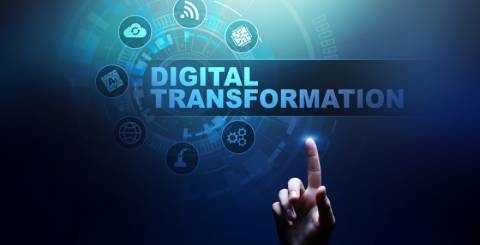Future of Digital Transformation

As always, the business is dead. Science fiction is becoming an increasing science fact. Digital transformation is more like a journey than a single leap from paper-based to digital technology and gaining digital competencies is an important part of the overall transformation strategy for companies on the path to digital innovation. A digital transformation strategy is an action plan aimed at consciously relocating an organization in the digital economy. Many organizations are transforming themselves and becoming more “digital”. A digital transformation plan like the McKinsey 7S digital transformation model is used to ensure that an organization is tuned in executing its strategy in a coordinated way.
Digital transformation is making a big difference in business processes and people, which are even more important than the technology itself. In other words, it's a broader business transformation. Digital transformation spaces are constantly changing at an alarming rate. Tracking trends and preparing for future change is critical to successful transformation. Currently business is experiencing unparalleled technological changes that are transforming every company in the world. This megatrend is called digital transformation.
1. Future Challenges of digital transformation
2. Future digital transformation uses all types of technology
3. Digital transformation change areas
4. Advantages of digital transformation
Future Challenges of digital transformation
Digital transformation has no ultimate goal. Everything is very dynamic and the goals change and evolve, so there is only a temporary end goal.it is better to take temporary end goal in mind and create a roadmap for the future.
Future Challenges of digital transformation will include
• How to transform the customer experience, Operational process and Business model, where should the company go? Who will lead the effort? How to "sell" the vision to key stakeholders, where should a company be in the digital ecosystem, how to make decisions during transformation, allocate funds quickly and dynamically, and what to do as the end goal of a digital transformation project always dynamic?
• How to Align with the virtual method to the company method and align skills, people, and alternate methods through virtual enablement?
• How to Create a plan like McKinsey 7S to broaden virtual management talents and verify management’s readiness for Implementing it?
• How to develop a brand-new company layout to embody the virtual lifestyle and verify new functionality wishes to broaden a virtual skills method?
• How to transition the personnel to the brand-new virtual company, align overall performance metrics, and plan to sustain?
• How to Alter organisational structure? Younger individuals of a company can be extra tech-savvy and apprehend era higher. However, the older extra senior individuals of a company have the higher commercial enterprise acumen.
• How to Think like a campaigner till the transformation
• How to maintain cooperation and coordination among crew silos and departments
• How to budget and useful resource allocation
• How to get the full backing of the management crew
• How to ensure regulatory and government compliance
The future digital transformation
The future digital transformation uses all types of technology. It is evolving at a pace that none of us has ever experienced. Tomorrow because of digital transformation, you will have positions like financial transformation consultants, SCM digital cloud transformation consultants, cloud consultants, digital security consultants, DevOps consultants, digital lean consultants and so on.
The digital transformation uses all types of technology to automate your business with Leadership development and Change management such as Cloud computing public cloud (45%) and Personal cloud (53%), ERP (Enterprise Resource Planning) software, CRM software (customer relationship management), HCM software (human capital management), SCM (Supply Chain Management) software, Business intelligence, Machine learning, Artificial intelligence, Predictive Analytics, Robotics, Industry 4.0, Internet of Things, Mobility and Cell technology (59%), Data Analytics/Massive information (58%) and APIs (40%), Data analysis, Digital security, and DevOps.
Digital transformation change areas
Research finds many digital transformations change areas including understanding customer wants and needs, increasing topliner revenues, opening new touchpoints for customers, automation of operations, knowledge sharing, performance management, digitizing parts of the business, creating new business models and Digital globalization. Virtual transformation is associated with people, approaches and technologies.
A Virtual Digital transformation roadmap of many companies consists of identifying your organization's ambitions based on where the value shifts, designing a transformation program for a profitable customer journey, making a difference through your partner ecosystem, reducing the risk of the transformation process to maximize the chances of success, improve techniques to boost up the virtual switch, update e-trade programmes and websites to lead them to a cellular-friendly environment, incorporate e-trade, cellular, web, social and carrier efforts to offer clients a clean experience, design a complete social media plan, redesign the complete customer support procedure to satisfy and ultimately exceed the expectancies of clients, allocate greater funding in IT and requirement of latest competencies.
The importance of digital transformation is felt when you aim at accelerated adoption, avoidance of costs, gaining an aggressive edge, improved efficiency, minimizing abilities shortage, defining ambition for the future and Mitigation of risks.
Advantages of digital transformation
Digitization improves efficiency through changing non-virtual procedures with virtual procedures or changing vintage virtual technology with new virtual technology. It also gives enterprises several advantages that include improving ordinary patron experience, leading to higher insights with the assistance of virtual analytics, encouraging departments to collaborate, improving innovation, pace and records protection and transparency, improving the information and skill set of employees, developing virtual leaders, rewire the company and increased people engagement and involvement.
Finally, beyond technology, we need to define true human value in this new digital ecosystem.
Similar Articles
For modern businesses to thrive, ensuring the effective management of inventory stands has become vitally important. Inventory management stands as a cornerstone of success. And the emergence of the Internet of Things (IoT) has introduced a new era of connectivity and efficiency across diverse industries.
Do you know what the following e-commerce companies have in common: Amazon, Walmart, eBay, and more? All of these e-commerce companies' apps make use of Java. Java is decidedly among the leading choices of programming language for e-commerce applications because it offers a world of benefits; for example, since Java code can be run on any platform with a Java Virtual Machine (JVM), users of e-commerce apps made with Java can access the said apps on a variety of devices.
Nikola Tesla in 1926, once described what is now called a mobile phone as a telephone that can fit into one's “vest pocket.” As otherworldly as that idea was then, nearly a century later, the reality is even more astounding.
Given the staggeringly high amounts of data being generated worldwide every single day, it ought to come as no surprise that organizations often struggle to pick the right tools to help them effectively harness the potential of all their data.
Managing properties can be a difficult task with the right tools. Property owners must find and use the best property management software. It can be a long and tedious process as there are many options in the property management software market.
In the ever-evolving financial services landscape, industry challenges are numerous and complex. From stringent regulations to rapidly advancing technology and changing consumer expectations, financial institutions face many obstacles.
The human learning capability is a great resource for helping technology evolve and grow, breaking boundaries, and creating new ones. Emulating the ability of humans to learn at a gradual but retentive pace, Machine Learning is the latest power monster that is redefining human-machine interaction.
In the ever-evolving landscape of low-code development, Microsoft's Power Platform stands out as a powerful tool for building custom applications. In today's dynamic digital landscape, creating and managing web pages is no longer the exclusive realm of professional web developers
In the data-driven business world, where information is of utmost priority, organizations are increasingly turning to data warehousing and data marts to harness the power of their data. These data management solutions are pivotal in transforming raw data into actionable insights.









